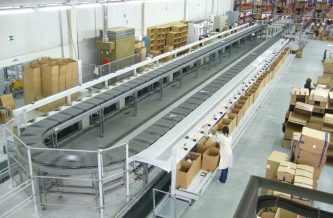How to Cut a Conveyor Belt

Conveyor belts play an integral part in major industries such as mining and manufacturing. A good conveyor belt design assures an efficient and cost-effective production line.
However, as with any moving components, it is subject to wear and tear over time, even with proper use. Once the belt is not as it used to be, the equipment can be prone to belt slippage and tracking errors. Any delay in the production line spells disaster. Aside from losing time and money, your company also loses the confidence of your clients that you always deliver on time.
To save you from the hassle of being in that situation, we have compiled some useful tips for you. In this short guide, we will go over the usual situations when you should cut conveyor belting and how to properly go about it. This seemingly minor procedure is a real lifesaver.
Reasons to Cut a Conveyor Belt
- The belt is worn out
With regular operation, the friction from the objects being ferried on top and the snub rollers from under induces a thinning of the belt thickness. Often, the thinned parts are not uniform, making the belt’s movement inefficient and also causing errors in the machine. - The belt was cut incorrectly, causing tracking errors
From manufacturing, the steel cord conveyor belt you have purchased may have imperfections. Even slight deviations may cause errors on the machine, eating up time as you try to find the root of the problem. - The width of the belt is more than what is needed
There are times when the belt that you have ordered is wider than what is needed on your equipment. Cutting the extra width will result in a more efficient conveyor machine. The trimmings can then be used for other purposes so that nothing goes to waste. - To save on materials
Oftentimes, ordering a wider or longer belt will afford you bigger discounts. You can simply trim the extra and save it for later use.
How to Cut a Conveyor Belt
What to Use to Cut a Conveyor Belt?
- Utility knife
The customary way of cutting rubber conveyor belts is using an electric knife. The Stanley knife, a trusted industrial brand, is wielded by an operative to cut the belt manually. This method of cutting has been deemed unsafe due to the accidents that have occurred on the field. Considerable force is needed to slice through the tough material of the belt. When the knife accidentally comes free of the rubber, the force exerted now swings the blade towards the user and can cut any part of the person badly.
- Mechanical belt-cutting tool
This contraption is composed of a clamp-like mechanism and a cutting tool. You anchor the belt in the steel clamp to keep it in place. Cranking the handle draws the blade across the belt. This is a safer way to cut belting. Although, it is not applicable to every circumstance.
- Electric belt cutter
An electric belt cutter is a handheld device powered by a battery or directly plugged into a power source. The powerful blade rotates and slices the belt easily, like a hot knife going through butter. The downside to this method is that the blades tend to get dull fast, as well. Dull blades can leave you with a belt carcass that is unusable. Purchasing extra blades proves to be quite costly.
- Slitting machine
Companies specialising in conveyor belts usually own an industrial slitting device. It has a table with rollers that feed the belt to a stationary blade. This process cuts the belt fast and accurately; even narrow belts are done easily. However, if your company won’t be using this machine often, it is not a practical buy.
Cutting Conveyor Belting Safety Measures.
- Wear proper PPE (Personal Protective Equipment).
Thick PPE, gloves, an apron, and goggles should be worn by the person cutting the belt. This prevents major injuries that might be incurred from the sharp blade.
- Make sure the knife blade is sharp.
Even the sharpest metal cutting blade will become dull from going through a tough belt. Always have on hand extra razor knife blades. Check the sharpness of your blade every 3 meters or so of slitting.
- Cut away from the body.
Always angle the blade away from your body when making cuts. This ensures that even if the blade disengages from the belt, the trajectory of the blade is away from your body.
Steps to Cut a Conveyor Belt Properly.
- Measure and mark the belt.
Be sure to use a straight edge to keep the belt edges perfectly straight. Jagged or even slightly curved edges can trigger tracking errors during operation.
- Make controlled cuts.
Using big, powerful strokes may lead one to believe that it finishes the job faster. But in reality, making small, measured cuts is the way to go. It provides more accuracy and helps you cut the belt easily. Maintain this pace, and you will have a nicely cut belt from start to end.
Other Things You Should Know Before Cutting a Conveyor Belt
- Cutting thick belting takes a lot of energy. Cutting through long belts will take a considerable toll on your hands and wrists.
- Cutting takes time. If you are not using industrial cutters, manual cutting will take some time.
- Weather conditions affect cutting. Be extra careful during wet or cold weather. This makes the belt tougher and more slippery, which can cause accidents.
In Summary
Conveyor belts make production efficient. Despite their heavy-duty quality, belts are still prone to wear, which may result in errors in the machine. To avert this situation, it is best to cut and splice the faulty belt segments before it causes damage and delays.
Therefore, routine inspection and timely maintenance is the key. It will save you time and money in the long run. For professional servicing, you can rely on Belle Banne Conveyors, Australia’s leader in the field. We offer various conveyor belt designs, conveyor parts, modular conveyor belt solutions, and conveyor maintenance services.
Contact our experts today to get the best solution for your needs!


